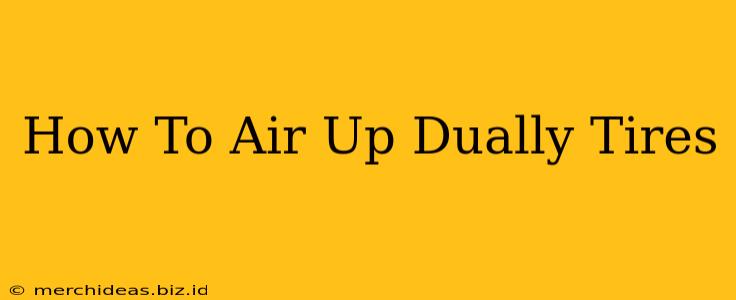Dually tires, with their dual rear wheel setup, offer increased load capacity and stability, especially crucial for heavy-duty trucks and towing applications. However, properly inflating dually tires is more involved than single-wheel setups. This comprehensive guide will walk you through the process, ensuring you maintain optimal tire pressure and safety.
Understanding Dually Tire Pressure
Before you even begin, it's crucial to understand that dually tires require precise inflation. Unlike single tires, the pressure needs to be consistent across both tires on each axle. Incorrect inflation can lead to uneven wear, reduced fuel efficiency, and potentially dangerous driving conditions.
Checking Your Tire Pressure Information
Always refer to the sticker located on your driver's side doorjamb or your owner's manual. This sticker specifies the recommended tire pressure (PSI) for your specific vehicle and load conditions. Never guess; always consult this information.
The Equipment You'll Need
Having the right tools makes the job easier and safer. You'll need:
- A reliable tire pressure gauge: A gauge that is accurate and easy to read is essential for precise inflation. Avoid cheap, inaccurate gauges.
- An air compressor: Choose a compressor with sufficient capacity to handle the volume of air needed for dually tires. A portable compressor might work for minor adjustments, but a larger, stationary compressor is ideal for significant inflation.
- A valve extender (optional but recommended): Dually setups often have limited access to the valve stems. A valve extender helps reach them easily and safely.
Step-by-Step Guide to Airing Up Dually Tires
1. Safety First: Park your vehicle on a level surface, engage the parking brake, and turn off the engine. Always wear appropriate safety gear, including gloves if you prefer.
2. Check the Current Pressure: Before adding air, use your pressure gauge to check the current pressure in each tire of the dually setup. Note the readings carefully.
3. Add Air Gradually: Using your air compressor, add air to each tire gradually. Avoid over-inflation, which can damage the tire. Monitor the pressure gauge closely and stop adding air once you reach the recommended PSI.
4. Double Check: Once you've reached the desired PSI on one tire, repeat the process for the other tire on the same axle, ensuring both tires have the same pressure. Do this for both axles.
5. Repeat for all Dually Tires: Repeat steps 2-4 for all dually tires. It is important to make sure all tires are at the recommended pressure for optimum driving experience.
6. Monitor Regularly: Regularly check your dually tire pressure, especially before long trips or when hauling heavy loads. Fluctuations in temperature can affect tire pressure.
Troubleshooting Common Issues
- Slow Leak: If you find a tire constantly losing air, there may be a leak. Have it professionally inspected and repaired.
- Uneven Wear: Uneven tire wear is often a sign of improper inflation or other mechanical issues. Take your vehicle to a qualified mechanic for diagnosis.
Maintaining Your Dually Tires
Regular maintenance is crucial for extending the life of your dually tires and ensuring your safety. This includes:
- Regular tire rotation: This ensures even tire wear across all tires.
- Wheel alignment checks: Proper wheel alignment prevents uneven wear and maximizes tire life.
- Visual tire inspections: Regularly check for cuts, bulges, or other damage.
By following this guide, you can confidently and safely maintain the proper tire pressure in your dually tires, ensuring optimal performance, safety, and a smoother ride. Remember: consistent monitoring and proper inflation are key to maximizing the life and performance of your dually tires.
